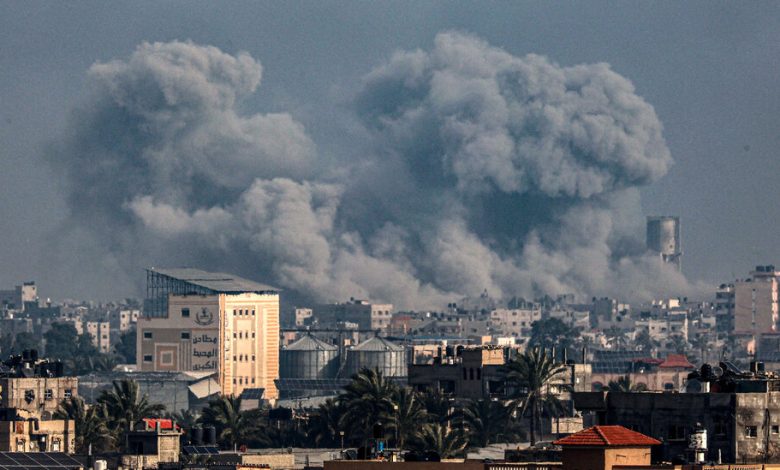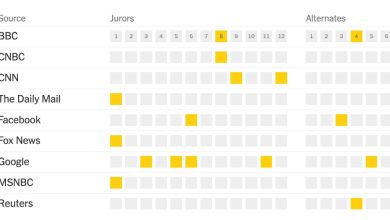As Fighting Intensifies in Southern Gaza, Palestinians Flee Hospital Refuge

Scores of displaced Palestinians fled the grounds of a hospital in southern Gaza as fighting raged on Wednesday in and around the city of Khan Younis, where the Israeli military says it is trying to crush a Hamas stronghold.
Videos verified by The New York Times show families fleeing the hospital, Nasser Medical Center in Khan Younis, carrying duffel bags, backpacks and blankets as the sound of explosions reverberated. The Israeli military said this week that they had detected mortar fire aimed at its forces from the hospital complex, the largest in the southern Gaza Strip.
The fighting around the hospital underlines the dangers for civilians in southern Gaza as the Israeli military converges on Khan Younis. About 7,000 people were believed to have been sheltering on the hospital’s grounds, the United Nations’ humanitarian office said on Wednesday, adding that an “intensification of hostilities” in the area also made it harder for patients and health workers to get access to the hospital.
Many displaced Palestinians in southern Gaza have relocated several times since the war between Israel and Hamas began on Oct. 7, an experience that has reinforced the feeling that nowhere is safe in the enclave. The Gazan health authorities say that more than 24,000 people, including women and children, have been killed in the enclave since then.
Hamas’s Khan Younis brigade is among the armed group’s last major forces, as their fighters in northern Gaza have been largely subdued, according to Israeli military officials. Israeli troops, led by the military’s 98th division, have been advancing into the Palestinian city since December, after the collapse of a brief cease-fire with Hamas.
Civilians, many of whom fled northern Gaza following Israeli evacuation orders, have taken refuge in makeshift tent cities, overflowing schools and on the grounds of hospitals.
The battles for southern Gaza, Israeli military officials say, are extremely challenging because of the presence of those civilians and Hamas’s tactic of embedding weapons and fighters among the population and around civilian infrastructure.
The fighting is further complicated by a network of war tunnels that Hamas constructed beneath the enclave, at times running beneath residential areas and, in at least one known instance, accessible from the grounds of a hospital.
Top Hamas leaders such as Yahya Sinwar — a native son of Khan Younis — may be hiding in fortified tunnels underneath his hometown, Israeli officials say. If so, they add, he has most likely surrounded himself with some of the more than 100 Israeli hostages remaining in Gaza — another stumbling block.
The southern portion of the Gaza Strip is about seven miles wide. But in a measure of the difficulty Israel is having in gaining control of that part of Gaza, the military said on Wednesday it had airdropped 16 tons of ammunition, fuel, water and food for its troops there.
Amid the Israeli airstrikes and intense fighting, hospitals in Gaza have struggled to deal with a seemingly constant stream of wounded people, grossly inadequate medical supplies, unsanitary conditions and significant staffing challenges.
The United Nations said on Wednesday that Nasser and two other major hospitals in Gaza were at risk of being shut down because of evacuation orders for areas next to the medical facilities, as well as fighting close by.
The World Health Organization reported that Nasser hospital alone treated 700 patients on Monday, double its usual daily caseload, requiring some patients to be cared for on the floor. Only 15 out of Gaza’s 36 hospitals are even partly functional, the W.H.O. said.
Israel has accused Hamas of using hospitals for military purposes, and its raid on Al-Shifa Hospital in northern Gaza revealed a stone-and-concrete tunnel shaft below the hospital. Israeli forces raided Al-Shifa Hospital in November, a move that officials from the Gaza Health Ministry said put the hospital out of service at the time.
Rear Adm. Daniel Hagari, the chief spokesman of the Israeli military, said on Tuesday that the army had detected the launch of a munition from the Nasser complex toward Israeli soldiers. The Israeli military later clarified that he had been referring to mortar fire.
“The Hamas terrorist organization systematically operates in Gaza’s hospitals and nearby areas using civilians as human shields,” he wrote on social media.
Hamas denies its fighters have used hospitals as bases for their operations.
The Times was not able to reach medical workers at the hospital on Wednesday as a near-total communications blackout across the Gaza Strip continued for a sixth consecutive day, leaving besieged civilians unable to call for help and aid workers struggling to reach them as Israeli airstrikes rained down on the south.
Paltel, the strip’s largest telecommunications company, said the blackout was the longest of several Gaza had faced since the start of the war.
Airstrikes and fighting between Israeli soldiers and Palestinian militants in Khan Younis have been so intense that repair crews have had trouble reaching the damaged sites, Paltel said. Last week, two of its workers, in the process of making repairs, were killed when a company car was fired upon, Paltel said, adding that it had coordinated the repairs with the Israeli authorities in advance. The Israeli military said the episode had been referred for investigation.
Even as the fighting continued, some officials were looking ahead to reconstruction once hostilities had ended. Rebuilding housing will cost at least $15 billion, Mohammad Mustafa, the chairman of the Palestine Investment Fund, whose board is appointed by the president of the Palestinian Authority, said on Wednesday. Speaking at the World Economic Forum’s annual meeting in the Swiss ski resort of Davos, Mr. Mustafa said the estimate did not include hospitals and infrastructure damaged or destroyed.
The U.S. secretary of state, Antony J. Blinken, who was also in Davos, said on Wednesday that the civilian suffering in Gaza was “gut wrenching” and that American officials had spoken to Israeli officials about their responsibility to minimize civilian casualties and facilitate humanitarian aid.
Mr. Blinken’s comments, while cast in unusually sharp language, were also a defense of the Biden administration’s approach to the conflict, in which it has strongly backed Israel’s war against Hamas while pressing Israeli officials to limit harm to Palestinian civilians.
“The suffering we’re seeing among innocent men, women and children breaks my heart,” he said in response to questions by The Times columnist Thomas Friedman. “The question is, what is to be done?”
“We’ve made judgments about how we thought we could be most effective in trying to shape this in ways to get more humanitarian assistance to people to get better protections and minimize civilian casualties,” he went on. “Every step along the way, not only have we impressed upon Israel its responsibilities to do that, we’ve seen some progress in areas where, absent our engagement, I don’t believe it would have happened.”
Mr. Blinken’s comments were consistent with the U.S. government’s broad political and military support for Israel’s military offensive in Gaza, which began after the Hamas-led attack killed about 1,200 people and more than 200 others were taken hostage on Oct. 7, Israeli officials said.
Also on Wednesday, the Israeli military said it had killed a Palestinian militant commander, Abdullah Abu Shalal, alongside several fellow fighters in the occupied West Bank in an airstrike targeting their vehicle.
The army described Mr. Abu Shalal as the commander of a militant cell based in the city of Nablus that was planning an “imminent” attack against Israelis. Palestinian officials said the men were members of the Al-Aqsa Martyrs’ Brigades, an armed group loosely affiliated with Fatah, the dominant Palestinian political faction in the West Bank.
Reporting was contributed by Matthew Mpoke Bigg, Nader Ibrahim, Malachy Browne, Anushka Patil, Roni Caryn Rabin and Gabby Sobelman.




